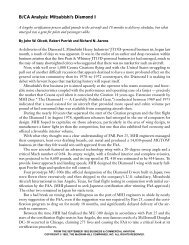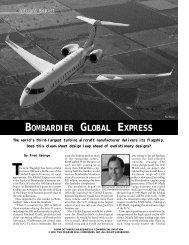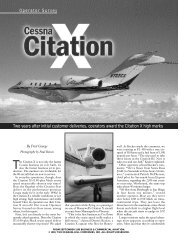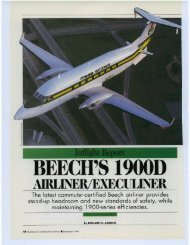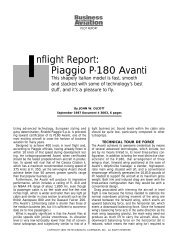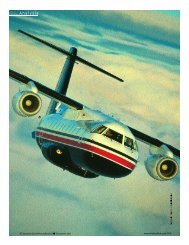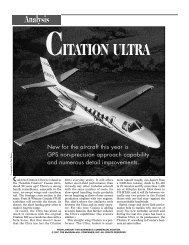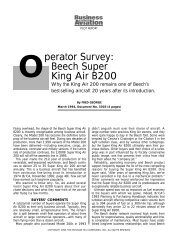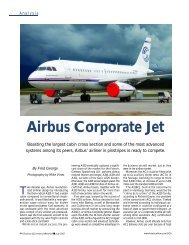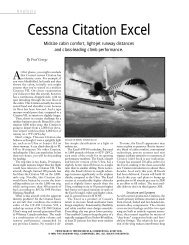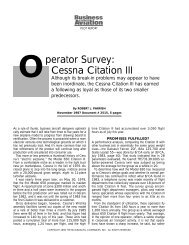B/CA Analysis: Cessna Citation V
B/CA Analysis: Cessna Citation V
B/CA Analysis: Cessna Citation V
- No tags were found...
Create successful ePaper yourself
Turn your PDF publications into a flip-book with our unique Google optimized e-Paper software.
PILOT REPORTB/<strong>CA</strong> <strong>Analysis</strong>:<strong>Cessna</strong> <strong>Citation</strong> V<strong>Cessna</strong>’s new top-of-the-line <strong>Citation</strong> V meetsits designers’ promises and brings the fleetto full maturity.By RICHARD N. AARONSJuly 1989 Document #2511, 10 pages<strong>Cessna</strong> now is delivering production <strong>Citation</strong> V’s-thecompany’s latest 500-Series twin-jet business transport.<strong>Cessna</strong> marketing executives are betting that this <strong>Citation</strong>will become its fleet leader and the mainstay of<strong>Cessna</strong>’s 500-Series production well into the nextdecade. After flying the first production airplane andlooking at final engineering performance data, wehave to agree.The <strong>Citation</strong> V is the latest offering in a line thatextends back to 1972 when <strong>Cessna</strong> delivered the firstModel 500 <strong>Citation</strong>. That airplane had seating for fivepassengers, a maximum gross takeoff weight of11,500 pounds and was powered by two P&W JT15Dpowerplants rated at 2,200 pounds-thrust each.The years since have seen the production of over1,560 <strong>Citation</strong>s in various configurations, growing insize and capability from the standard <strong>Citation</strong> (Model500) through the <strong>Citation</strong> I (Model 501), <strong>Citation</strong> II(Model 550) and <strong>Citation</strong> S/II (Model S/550) to thenew <strong>Citation</strong> V (Model 560). Not included in the totalabove are 15 Navy T-47A trainers, a derivative of theS/II. The current production fleet includes the <strong>Citation</strong> IIand the <strong>Citation</strong> V. The <strong>Citation</strong> V is a logical step in<strong>Citation</strong> genesis-one that brings the 500-Series line tofull maturity.While the <strong>Citation</strong> V deserves to be measured on itsown strengths and weaknesses, understanding thedesign concept behind its development may be donebest by looking at the differences between it and its predecessor,the S/II.First, the <strong>Citation</strong> V is longer-20 inches longer. Theincreased fuselage length is not a “plug” in the traditionalsense, but instead represents an extended fuselageproduced on new tooling. The extension has beenadded between the forward entrance door and thewing’s leading edge.The new length provides room for an extra cabin windowon each side. (A quick way to identify <strong>Citation</strong>s sittingon a ramp is to count windows. The new <strong>Citation</strong> Vhas seven windows per side; the <strong>Citation</strong> II and S/IIhave six per side; The <strong>Citation</strong> I and <strong>Citation</strong> 500 bothhave four windows per side.)The original <strong>Citation</strong> measured 43.5 feet fromradome to taillight. Its cabin length was 12.7 feet measuredfrom cockpit bulkhead to the back of the rearmostseat. External length of the <strong>Citation</strong> II and S/II is 47.2feet; cabin length is 16 feet.As the <strong>Citation</strong>s got longer and heavier, their originalfingertip pitch control forces-especially rotation forcesbecamesignificantly heavier, so much so, in fact, that aforward-loaded S/II can require a two-arm curl at VR.<strong>Citation</strong> engineers realized that the long-fuselage<strong>Citation</strong> V would need a new, more powerful horizontalstabilizer to relieve the rotation forces and to maintain acomfortable c.g. range with the fuselage stretch-so the<strong>Citation</strong> V got new tail feathers.COPYRIGHT 1995 THE MCGRAW-HILL COMPANIES, INC. ALL RIGHTS RESERVED
P ilotReportThe <strong>Citation</strong> V’s horizontal stabilizer and full-span elevatorsections measure 21.5 feet, tip-to-tip, comparedwith the 19-foot span of the <strong>Citation</strong> II tail.The area of the <strong>Citation</strong> V’s horizontal tail is 84.8square feet compared with 69.8 square feet for the<strong>Citation</strong> II and S/II. The aspect ratio of the new tail is5.43 compared to 5.96.Of course, there’s a lot more beef in the vertical stabilizerand in the empennage itself to handle higher rotationand inflight loads.INCREASED POWER AND RELIABILITYThe final major element in <strong>Citation</strong> V evolution is representedby its powerplants. <strong>Cessna</strong> listens to its owners,and the item at the top of every <strong>Citation</strong> owner’s wishlist always has been “more power.” More power wouldhelp with the rest of the wish list items that usuallyinclude “higher, faster cruise at heavier weights.” Thusthe change to the latest in P&W small-engine technology-theJT15D-5A.The -5A engine develops 2,900 pounds static thrustcompared to 2,500 pounds for the -4 engine used onthe <strong>Citation</strong> II. The -5A has a new, high-efficiencyexhaust nozzle and its bypass ratio is reduced to 2.1-to-1 compared with 2.5-to-1 for the -4. The reduction inbypass ratio improves altitude performance.<strong>Cessna</strong> elected to outfit the -5A engines in this installationwith hydromechanical fuel controllers rather thanthe electronic fuel controllers mounted on -5s that powerthe T-47 <strong>Citation</strong> derivative. Mechanical fuel controllersimprove dispatch reliability, while electronic fuel controllersreduce cockpit workload. <strong>Cessna</strong> believes thatcorporate operators will gladly put up with power monitoringchores to avoid some of the maintenance hasslesinherent to electronic fuel controllers. On the otherhand, the U.S. Navy’s training mission can be prettyrough on engines, and the military seems willing totrade dispatch reliability for insurance against engineovertemps and overtorques committed by ham-handedstudents. Target-type, hydraulically actuated thrustreversers are standard.MORE MEANS MOREDevelopment of the Model 560 gave the Wichita companya chance to make several other substantialimprovements. The TKS leading edge anti-ice systemthat was introduced on the S/II is gone (few tears willbe shed). The messy, heavy TKS has been replaced bylow-profile inflatable boots on the outboard panels andby bleed-air-heated leading edges on the inboard sectionsforward of the engine intakes. Nose and tail baggage-doorlocks and the door-ajar warning circuitryhave been changed to improve door security and toreduce false warnings.Interior changes begin in the cockpit with standardtwo-tube, Honeywell EFIS on the left side and a Global-WulfsbergGNS-X nav management system (completewith Loran-C sensor) in the console between thepilots’ seats.Improvements in the passenger cabin are impressive,too. The 20 inches of fuselage stretch belongs to thesame seven-to-nine passenger seats that occupied theshorter-fuselage <strong>Citation</strong>s. In other words, <strong>Cessna</strong> didn’tattempt to cram more seats into the space but ratheruses it to give <strong>Citation</strong> V passengers more light and livingspace.The standard fully articulated passenger seats havebeen redesigned to take advantage of the stretch byreclining a full, almost berth-like 60 degrees. Lumbarsupport has been improved, too. New soundproofingand triple-glazed elliptical windows make the <strong>Citation</strong>V’s cabin one of the quietest in the industry.What all these changes and improvements mean tothe crew and passengers can be best seen aloft. B/<strong>CA</strong>had the opportunity to fly the first production aircraftavailable with a complete interior- <strong>Cessna</strong>’s demonstrator,N562CV-shortly after it was certificated.FLYING THE CITATION VOn our way to the <strong>Citation</strong> V’s spot on the delivery center’sapron, we climbed aboard a <strong>Citation</strong> II demonstratorand sat in the back to reacquaint ourselves with its(relatively) short fuselage.After a little while we moved on to the <strong>Citation</strong> V andimmediately felt the positive effect of the lengthenedcabin. That extra 20 inches provides a significantadded feeling of spaciousness. Inclusion of the extrawindows increased general cabin brightness and thusprevented the tunnel effect that sometimes occurs whenan airplane is stretched.While we were still on the ground we sampled the<strong>Citation</strong> V’s new “deep reclining” (brochure words)passenger seats. The brochures were correct: Lumbarsupport is much improved over earlier efforts.The seats, which track laterally and rotate 360degrees, are solid and well-crafted as are the other interiorelements. Cabinetry is tight, hinges align and drawershave a massive feel. Of course, this is as it shouldbe in a new aircraft, but our evaluation pilots havebeen disappointed often by the lack of interior craftsmanshipin some of the new offerings of various airframemanufacturers.One sign of the times can be seen in the <strong>Citation</strong> V’sashtray design. The ashtrays at each seat can be convertedto cup/glass holders in two seconds for thosecorporate airplanes on which smoking is forbiddenwhichis more the rule now than the exception. Whilethis is a small item, it shows that <strong>Cessna</strong> interiorCOPYRIGHT 1995 THE MCGRAW-HILL COMPANIES, INC. ALL RIGHTS RESERVED
P ilotReportdesigners are paying attention to small details, andthat’s good.<strong>CA</strong>BIN COMFORTSDuring the evaluation flight, B/<strong>CA</strong>’s pilot climbed out ofthe cockpit and went aft to sample this interior aloft. It’sa winner in every respect.<strong>Cessna</strong>’s efforts at sound control are especiallyapparent. The evaluation pilot sat in the rearmost cabinseat and held a normal-voice conversation with thedemonstration pilot in the copilot seat. The airplanewas at max cruise speed at FL 430.While we may be getting ahead of the demonstrationflight chronology, it seems appropriate to notenow that cabin pressure and temperature were controlledflawlessly. Despite rapid power manipulations,engine shutdowns and a max-effort descent thatpegged the IVSI at 6,000 fpm, we didn’t suffer a singlepressurization bump or ear pop. Ventilation isthorough and not at all drafty.The <strong>Citation</strong> V has a nominal working maximum pressuredifferential of 9.0 psi compared with 8.7 psi forearlier <strong>Citation</strong>s. Thus the Model 560 can maintain asea-level cabin at 23,586 feet and 8,000-foot cabin altitudeat its maximum certified altitude of 45,000 feet msl.Getting back to the chronology, <strong>Cessna</strong> demonstrationpilot Steve McCartney hosted B/<strong>CA</strong> on a first-flightof-the-daywalk-around inspection. The first thing wenoticed was the generally high quality of the exteriorworkmanship-both sheet metal and finishes.THE RETURN OF CRAFTSMANSHIPIf we seem to be devoting a lot of type to issues of detailand craftsmanship, it’s only because <strong>Cessna</strong> has madesuch an obvious effort in this area. The <strong>Citation</strong> folkshave learned much over the years about the importanceof little things-making butt joints tight, finishes smooth,screws align and the like-and it shows. Details havebeen thoroughly attended to in this airplane.Members of the <strong>Citation</strong> family always have been relativelysimple to preflight because all the important stuffis either reachable or visible from a solid footing on theramp. It also is possible to reconnect the batteries andto check hydraulic fluid and other consumables, withoutruining your suit coat or pants knees.Pilots familiar with earlier <strong>Citation</strong>s will have toremember to key-lock the nose baggage area accessdoors or they’ll get a warning light on power-up.New stops on the preflight include wing-root NA<strong>CA</strong>vents for the wings’ leading edge bleed-air anti-ice systemand its cone-shaped exhaust outletsat the wing-root trailing edge.These stops involve only checks forobstructions.With the preflight complete, weclimbed into the cockpit. The <strong>Citation</strong>V’s cockpit will make any pilotfeel right at home, whether he orshe is an old hand or brand new to<strong>Citation</strong>s.COCKPIT DELUXEIn the opinion of B/<strong>CA</strong>’s evaluationpilot, the <strong>Citation</strong> V cockpit is simplybest in class. It’s big-and that’s a plusfor those of us who don’t fit into theclassically thin profile that some ofour colleagues are able to maintain.Its fully articulated pilot seats arecomfortable and the new five-pointseat belts are snug without beingoverly restrictive. The cockpit visibilityfrom this airplane is hard tomatch. The view encompasses a full340 degrees: You can see the tipsof the horizontal stabilizer fromeither pilot’s seat.The accompanying photographsshow the <strong>Citation</strong> V’s unclutteredCOPYRIGHT 1995 THE MCGRAW-HILL COMPANIES, INC. ALL RIGHTS RESERVED
P ilotReportCESSNA CITATION VB/<strong>CA</strong> EQUIPPED PRICE $4,321,900SEATS (crew/pax) 2+7/9ENGINEModel2 P&W JT15D-5APower2,900 lb eaDESIGN WEIGHTS(lb/kg)Max ramp 16,100/7,303Max takeoff 15,900/7,212Max landing 15,200/6,895Zero fuel 11,200/5,080BOW 9,400/4,264Useful load 6,700/3,039Max payload 1,800/816Max usable fuel 5,771/2,618Payload (max fuel) 929/421Fuel (max payload) 4,900/2,223LOADINGWing (lb/ft 2 ) 46.4Power (lb/lb) 2.7PERFORMANCEClimb (fpm/mpm)All-engine 3,684/1,123Engine-out 1,332/406Maximum certificatedaltitude (ft/m) 45,000/13,716First step after MGTOWdeparture (ft/m) 43,000/13,106Engine-out service ceiling (ft/m) 25,900/7,894Max altitude for SL cabin (ft/m) 23,586/7,189High-speed cruise TAS (kt) 427Full fuel (pph) 1,526Flight level 330Specific range 0.38Long-range cruise TAS (kt) 50Fuel flow (pph) 740Flight level 450Specific range 0.47and functionally designed cockpit. (Note the gear handleon the left side. <strong>Citation</strong> V pilots can receive singlepilotoperating authorization in large part because ofthe simplicity of the <strong>Citation</strong>’s systems and the regardpaid by the cockpit designers to human factors issues.)As in earlier <strong>Citation</strong>s, the system switches in the <strong>Citation</strong>V are, for the most part, marked with a “norm”(normal) position and a something-else position. Thenominal cockpit configuration for all normal operationsis simply to have everything set to “on” or “norm.” Eventhose switches and selectors with complex functions aredesigned to be operated intuitively. The fuel cross-feedselector, for example, is a simple point-and-shootswitch. That is to say, you position the switch so theoperating engine symbol points at the appropriate tanksymbol and the management task is complete.Alas, few things are perfect, especially in a new aircraft.The top of the tire-shaped knob on the landinggear handle had been filed flat in this installation toprovide clearance for the radar mounting bezel whenthe handle is moved to the up position. Three times duringour trip the gear failed to retract when the handlehit the bezel and didn’t make the up-contact. We weretold the mechanics later fixed the problem by filing yetmore off the top of the flat-tire-shapedknob. Ultimately, <strong>Cessna</strong> may simply raise the radaran eighth of an inch or so and return the gear handle tothe shape described in the certification regulations.We also believe the avionics master and inverterswitches should be protected by a cover of sorts. Theseswitches are located very close to the igniter switchesthat must be moved to the off position immediately aftertakeoff. The EFIS display looks awfully bleak when youhit the avionics master instead of the igniter. Of coursethis couldn’t happen to a pilot well-trained and familiarwith the aircraft. . .or could it?Anyway, <strong>Citation</strong> aficionados will recognize the familiarengine instrument ribbons, but you also will noticethat they are now bezel-mounted rather than flush-mounted.<strong>Citation</strong> engineers told B/ <strong>CA</strong> the change was madeto make life easier for maintenance personnel. “It givesthem something to grab onto when they want to slip aninstrument out of the panel. It used to be they had toremove the radar and put a hand behind the panel topush out a flush mounted instrument....”THE GROUND IDLE SWITCHThe start sequence is semi-automatic. Place the batteryand generator switches to “on” and then push either“start” button. Actuation of the button energizes thestarter generator and the igniters.The selected engine spins up quickly to 12 percentN2 at which time the pilot moves the power lever out oflatch to turn on the fuel and then monitors temperatures.Pilots new to the JT15D-5A engine will find a newengine-control switch on the panel: the ground-idleswitch. It has two positions-high and normal-and itsfunction requires a bit of explanation.The -5 engine has a relatively high flight idle setting ofapproximately 52 percent N2 that can cause problemswhen taxiing. In fact, the airplane will creep up a prettysteep ramp into a headwind when its engines are idlingat 52 percent. Obviously, taxiing at such a high idlecould make short work of the brake pucks, too.The solution to the high idle problem is simply toreduce the idle when the aircraft is on the ground.When the ground idle switch is in the normal positionand the aircraft senses (via squat-switches) that it’s onthe ground, the ground idle control unit extends aplunger that moves the fuel control unit linkage from theflight idle position to a ground idle setting of approximately46 percent N2. This movement occurs behindthe scenes, so to speak, so the power levers don’t moveCOPYRIGHT 1995 THE MCGRAW-HILL COMPANIES, INC. ALL RIGHTS RESERVED
P ilotReportwhen this happens.While the low idle is enabled, the amber “groundidle” annunciator light is illuminated on the warningpanel.When the power levers are advanced and weightcomes off the squat-switches, the plunger lets go andlowest obtainable idle is set at 52 percent. There’s aneight-second delay built into the system. For example,when the airplane lands with the switch in the normalposition, the computer will not permit the engines tospool down to ground idle for eight seconds. This willretain high idle during the period in which the landingmight be rejected.The engines will remain at or above flight idle whenthe switch is selected to “high” regardless of the positionof the main gear squat switch. This switch must bein the “high” position when conducting touch-and-goesor when operating on the ground with the engine antiicebleed air on.It should be noted that it takes longer to explain thefunction of this switch than it takes to integrate it intocockpit routines.THE HONEYWELL PACKAGEAnyway, as soon as the engines are started and theinverters and avionics masters are activated, the fiveinchHoneywell EFIS displays wake up and your attentionis drawn to the heart of the panel.The <strong>Citation</strong> V’s standard avionics package includesa Honeywell SPZ-500 integrated flight director/ autopilotsystem using two five-inch EFIS (EADI and EHSI) indicatorson the pilot’s panel.Electrically powered mechanical ADI and HSI unitsmade by Honeywell are installed on the copilot’spanel. However, EFIS is optionally available for thecopilot’s side, as is a multi-function display (MFD) forthe center panel.The standard flight control system includes altitudealerting and reporting, altitude pre-select and a verticalnavigation system with vertical speed and indicated airspeedhold. An air data computer provides altitudeencoding and output to operate the left-hand servoedaltimeter. Heading information is provided by dual C-14 compass systems. The rest of the avionics suite comprisesdual Collins Proline II remote-mountedcommunications and navigation gear.Joining it all together is a Global Wulfsberg GNS-Xnavigation management system with a built-in Loran-Creceiver. The standard equipped airplane can beapproved for FAR Part 91 Category II operations.<strong>Cessna</strong> marketing executives told B/<strong>CA</strong> they electedto make EFIS standard “simply because it’s what customersexpect of a new airplane. Our experience hasbeen good in the S/II with a large number of customersCOPYRIGHT 1995 THE MCGRAW-HILL COMPANIES ALL RIGHTS RESERVED
P ilotReportFigure 1CLIMB PERFORMANCE(Weight: 15,900 Pounds)TIME DISTANCE FUELFL (min) (nm) (lb)350 17 69 535370 18 80 583390 22 96 643410 27 121 725430 37 170 877450 123* 700* 2,228**Step Climbordering EFIS, so it seemed the natural decision.”We liked the Honeywell EFIS. It provides a great dealof display flexibility and certainly increases a pilot’sability to get the big attitude/navigation/weather picturewith minimum scan.The benefits of EFIS are not without cost, however.Current EFIS runs hotter and is more expensive andheavier than electromechanical displays .There’s also a dispatch reliability cost. In order tokeep heat at reasonable levels, temperature probes anda temperature-controlled cooling fan guard the EFIStubes behind the <strong>Citation</strong> V’s panel. Annunciator lightson the panel let the crew know if a tube gets hot or ifthe fan is activated.EFIS ground operation with the pilot’s “EFIS fan”annunciator light illuminated is limited to 10 minutes oruntil either the “EADI hot” or “EHSI hot” annunciatorlight illuminates. Dispatch is prohibited if either of thoselights illuminates or, for that matter, if the “EFIS fan”annunciator stays on.Dispatch also is prohibited following a flight duringwhich either an “EADI hot” or “EHSI hot” annunciator lighthad come on until the condition is identified and corrected.B/<strong>CA</strong> has no reason to suspect that the average userever will run into dispatch problems; we mention it onlyto illuminate the point that there is more involved in theEFIS purchase decision than simply deciding whether ornot you like the picture displayed on the tube.Personally, we liked the displayed images. They wererock-steady and easily visible even when we maneuveredthe aircraft to put the sun directly on the instrumentfaceplates.A SMART CLIMBERFor our test hop we put power to the GNS-X, confirmedour present location on <strong>Cessna</strong>’s ramp at Wichita (ICT)by pushing the “enter” button and told the GNS wewanted go directly to the VOR at Pueblo, Colorado .We dialed FL 430 into the altitude pre-select anddouble-checked the fuel page on the nav managementunit. It confirmed a basic operating weight of 9,500pounds and a fuel load of 3,200 for a taxi weight of12,700 pounds.Ground handling through the rudder-pedal-steerablenosewheel is smooth and precise. Normal steeringrange is 20 degrees on either side of center, but if youdeflect a pedal fully and apply differential braking, thenosewheel will caster for a turn that pivots about themain gear. While we don’t recommend that you dothis, it can be handy in a tight spot.The flaps (two hydraulically actuated panels on eachwing) feature infinite positioning. Detents are providedat seven degrees for takeoff, 15 degrees fortakeoff/approach and 35 degrees for landing.We set the flaps at 15 degrees, moved the igniterswitches to “on” and moved the power levers to takeoffpower. Computed V, was 90, VR was 91 and V2 was101 knots.The ground idle system caution light is typically illuminatedon the panel for takeoff. B/<strong>CA</strong> would prefer tosee a “dark” warning panel when systems and configurationare normal. We were told, however, that onequickly gets used to the light. (We wonder if it’s really agood idea to get used to a light illuminated on the masterwarning panel. This could defeat its entire purpose.)Acceleration was rapid and directional control waspositive throughout. At the VR callout we rotated to 10degrees nose-up. Control forces weren’t quite as lightas those we remembered from the original Model 500,but they were significantly less than those we experiencedjust 16 hours earlier in a <strong>Citation</strong> S/II simulatorset for a similar weight and c.g.By the time we selected gear up we were acceleratingthrough V2 + 10 out of 400 feet agl. Retracting theflaps produced no detectable pitch trim changes. (Theflaps and elevator trim are interconnected to compensatefor configuration changes.)The only post-takeoff chores include moving theigniters to the normal position, setting climb power andengaging the altitude preselect.Initial climb rates were about 4,000 fpm departingICT in near-standard conditions. Admittedly, we were abit light, but as you can see in Figure 1, the <strong>Citation</strong> Vclimbs smartly even after a max takeoff weight(15,900-pound) departure.We tried the autopilot’s vertical modes during theclimb-indicated airspeed hold generated an attitudehuntingmotion (imprecision in the analog air data unit,we were told). On the other hand, the vertical-speedholdmode was quite steady.BUFFET BOUNDARY CONSIDERATIONSWe made it to FL 430 in just under 28 minutes despitethree short ATC holds.COPYRIGHT 1995 THE MCGRAW-HILL COMPANIES ALL RIGHTS RESERVED
P ilotReportOnce at altitude, we made a quick check of bookspeeds and fuel flows. We were showing about 390KTAS burning 970 pph total. (See accompanying specificrange data.)Our maneuvering trials at FL 430 were interesting.First, the airplane is quite agile in normal bankingmaneuvers. (Our indicated airspeed was about 220knots.)A 45-degree banked steep turn produced a little tailbangingas the airplane loaded up to about 1.5 g’s.<strong>Cessna</strong> aerodynamic engineers told us later that <strong>Citation</strong>sfinally are reaching altitude and weight combinationsthat can make buffet boundaries at least a passingconsideration for some operations, as it is with mostjets. The flight test engineers assured us there’s a verycomfortable margin between onset of mild tail bangand the actual stall. We also should point out that the<strong>Citation</strong> S/II was the first <strong>Citation</strong> to have buffet boundarytables in its flight manual, although our guess is thatmost <strong>Citation</strong> S/II pilots haven’t had reason to look atthose pages since initial training. Of course, the sweptwing,high-performance <strong>Citation</strong> III has such a pageand appropriate operational limitations.Now that the <strong>Citation</strong> V is approved for operations atFL 450, certification rules dictate it needs to be able toget down quickly- more quickly than the gear-up, spoilers-outdescent procedure used on earlier <strong>Citation</strong>s.Indeed, the emergency descent procedure for the <strong>Citation</strong>V involves throwing out the spoilers (at any speed)and then the gear at or below the new V, E of 250knots, then aiming the nose toward the ground (about25 degrees nose-down) and holding 0.755 Mach or250 knots. (The only modification to get the gear speedup to 250 knots was to add a bit more structure in thesmall keystone-shaped panel of the nosegear door.)The descent in this configuration is an impressive ride.We traveled from FL 430 to 16,000 feet in this attitudewith a descent rate well over 6,000 fpm. Again, theairplane is rock-stable with no tendency to slip awayfrom you or accelerate away from trim speed.We used a block of airspace between 14,000 and16,000 feet to look at low-speed handling, stalls,trim/configuration changes and engine-out maneuvering.Once again, the <strong>Citation</strong> genes showed, althoughthere is no question that the <strong>Citation</strong> V is more than aclone of its predecessors.Similarities and differences can be seen in stalls. Wetried several. In a clean, power-off stall the airplaneretains full aileron control right through the break-typical<strong>Citation</strong> all the way. However, the break itself and theroll-off were a little more abrupt than we rememberedfrom similar trials in the <strong>Citation</strong> II, although aileronpower is well within certification requirements. Later,we checked with the flight test engineers on this pointand they agreed: The <strong>Citation</strong> V can be a bit moreaggressive than earlier models in the stall, but againkeep in mind we’re comparing <strong>Citation</strong> with <strong>Citation</strong>.The break came at 88 KIAS when clean and 76 KIASin landing configuration.As a class, all <strong>Citation</strong>s have remarkably good lowspeedhandling characteristics and generally docilestall traits. The <strong>Citation</strong> V will do nothing to besmirchthe family reputation .A STEADY PLATFORM EASESWORKLOADB/<strong>CA</strong> editors often have expressed our belief that anairplane’s handling characteristics in approach maneuveringconfiguration arguably are the single mostimportant measure of aircraft pilot-friendliness and, ultimately,safety.Our theory is based on the fact that the approachphase requires the pilot to direct a good deal of attentionaway from basic aircraft handling. The list of attention-grabbingtasks includes altitude awareness,traffic-watching, navigation, communications, weatherand checklists.To the extent that any airplane’s handling characteristicsrequire an extra amount of crew attention, the otherapproach-related items must, of necessity, receive less.The results, we believe, can be seen in the accidentstatistics.Anyway, the <strong>Citation</strong> V, like its stable-mates, is asuperb instrument platform. We trimmed the airplane to150 knots-a typical initial approach maneuveringspeed-and then, keeping hands off the wheel, reconfiguredthe flaps, gear and spoilers.The airplane’s reaction to all these perturbationsrequired little if any pilot compensation. For example,the flaps are interconnected with the trim. Moving theflap lever from zero to the 15-degree approach settingat 150 knots causes a very slow deceleration while thenose settles a degree or two below the no-flap trim attitude.Gear extension and spoiler deployment both createonly minor trim changes.Book VREF ranges from 106 knots at max landingweight of 15,200 pounds to 88 knots at or below10,500. We made three approaches and landings toa full stop including one simulated engine-out arrivalwith asymmetric thrust reverse after touchdown. Weused a VREF Of 92 knots at our weight of just under11,500 pounds.The <strong>Citation</strong> V’s inherent stability in approach configuration(full flaps and gear with a fuel flow of about500 pph per side) and Honeywell’s EFIS single-cuecommand display combine to take most of the work outof the approach management task.Typically, the approach is flown at VREF+10 andCOPYRIGHT 1995 THE MCGRAW-HILL COMPANIES ALL RIGHTS RESERVED
P ilotReportspeed is reduced to VREF crossing the fence. The <strong>Citation</strong>V tends to approach at a slightly flatter attitude (asubjective observation, to be sure) than shorter models,and it also tends to be more of a floater, at least at ourweight. Nevertheless, it is a pleasure to land. It’ll makethe sloppiest of us look pretty good.We mentioned that one of our approaches was withan engine out. That maneuver was preceded by a V,cut on takeoff. Granted, we were relatively light andthe day was relatively cool, but this airplane stillremains better behaved in this situation than most jetsand just about all turboprops we’ve evaluated.You can cheat a bit after a V, cut by punching on theyaw damper as the wheels are coming into the wells.Doing so trims out the asymmetric rudder loads immediatelyand lets you concentrate on speed and pitch control.NO CORNER-CUTTINGThe <strong>Citation</strong> V’s price is $4.3 million. That priceincludes thrust reversers, the full complement of avionicsdiscussed above, a no-corners-cut executive interior witha enclosed toilet area and refreshment center.The <strong>Citation</strong> V warranty is five years for aircraft componentparts manufactured by <strong>Cessna</strong>, two years for<strong>Citation</strong> standard aircraft avionics and one year for allother optional avionics and vendor items.Engines and engine accessories supplied by Pratt &Whitney are covered under that company’s warranty.The basic engine warranty is two years or 1,000hours. Accessories supplied by P&W are warrantedfor one year.Training for one pilot, copilot and two mechanics alsois included in the purchase price and provided for <strong>Cessna</strong>by FlightSafety International. Construction of a <strong>Citation</strong>V Phase II simulator was nearing completion at thiswriting. Meanwhile, FSI was providing transition trainingfor <strong>Cessna</strong> crews in a modified S/II simulatorequipped with a Honeywell EFIS.B/<strong>CA</strong>’s evaluation pilot sampled FSI’s <strong>Citation</strong> V transitioncourse with a systems briefing and a simulatorsession. We also took the opportunity to take a look aFSI’s new <strong>Citation</strong> maintenance training facility. Boththe flight and maintenance training facilities are up toFSI’s usual high standards. Graphics and mockups forthe Model 560 are in place and the instructor staff is upto speed.THE ANALYSISThe charts and tables on these pages pretty much speakfor themselves. The strongest feature of the <strong>Citation</strong> Vfor many potential users is its ability to carry a fairlylarge payload over relatively long legs. Its ferry rangewith NBAA IFR reserves is about 1,900 nm; its maxpayload range is about 1,300 nm. And that max payloadis a full 1,800 pounds-basically seats-full.The <strong>Citation</strong> V’s airport performance is best in class,as has been the case with its 500-Series siblings. Forthe operator that has to get in and out of tight spotseven spots that make some of the larger turbopropsuncomfortable-the <strong>Citation</strong> V can’t be beat.On the negative side, the <strong>Citation</strong> V is not the fastestin class nor is it the most fuel efficient under all circumstances.However, be sure to examine the absolute differencesin speeds and fuel flows if you are consideringan aircraft in this class. A cost of a few pounds of fuelor an extra five minutes on a 600-nm trip may be offsetby cabin size, payload/range capability or even systemsdesign.Our overall impression of the <strong>Citation</strong> V is that it prettymuch meets the wish list presented to <strong>Cessna</strong> managementby the owners of earlier 500-Series <strong>Citation</strong>s.It’s bigger and faster, flies higher and farther and doesall that while not only retaining the good handling characteristicsof its immediate predecessor but, in fact,improving on them.<strong>Citation</strong> V demonstrators are beginning a worldwidetour at this writing and, between now and the end ofthe year, will be “at an airport near you soon.” Beg aride if you can. This is an airplane you’ll like. B/<strong>CA</strong>COPYRIGHT 1995 THE MCGRAW-HILL COMPANIES ALL RIGHTS RESERVED



